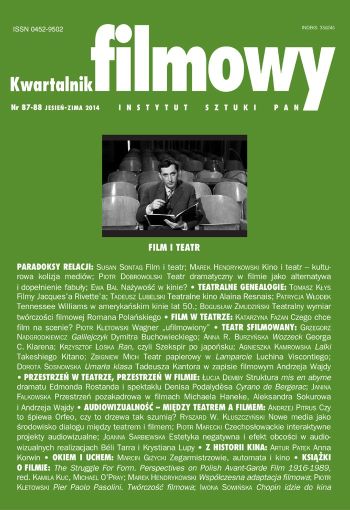Wobec Niemożliwego - estetyka negatywna i efekt obcości w audiowizualnych realizacjach Béli Tarra i Krystiana Lupy
In View of the Impossible - Negative Aesthetics and the Effect of Strangeness in Audiovisual Works of Béla Tarr and Krystian Lupa
Author(s): Joanna SarbiewskaSubject(s): Theatre, Dance, Performing Arts
Published by: Instytut Sztuki Polskiej Akademii Nauk
Keywords: Tarr Béla; Lupa Krystian
Summary/Abstract: Iconic revolution in culture is a "fait accompli". The contemporary primacy of image based consciousness was correctly recognised by Ferdinand Fellmann, who noted that it opposes the specifics of language based vision of the world by letting the dimension of the image which extends beyond intentional consciousness to take its full course. This iconic change is particularly important in the work of Béla Tarr and Kristian Lupa. Independently of the difference in media, it is in the audiovisual dimension of their work, that the negative aesthetics and the effect of strangeness are constituted, which resonate with Georges Didi-Huberman’s concept of "the power of visual event". The aesthetic strategy of both directors appears to be a cognitive one – deconstruction/cleansing of the visible in the film and theatre from positive means of presentation, linear narrative, the classic model of projection-identification serves the exploration of the Impossible. The negativity and strangeness of dark, empty spaces is revealed here in contemplative rhythm of nothing making and muting the structures of the world represented, or it emerges from gestures of audio-visual intensification, taken to the extreme and contrasted with phases of total silence and absolute stillness. The aesthetic apophasis, like Derridean "Khôra", aims at the experience of over-seeing (and over-hearing), realising a specific model of negative mysticism, which is initiated by the death of metaphysics of presence. The article examines this strategy using the examples of Lupa’s "Extinction" ("Wymazywanie") and Tarr’s "Damnation" ("Kárhozat").
Journal: Kwartalnik Filmowy
- Issue Year: 2014
- Issue No: 87-88
- Page Range: 262-270
- Page Count: 9
- Language: Polish

